2007 CHEVROLET CORVETTE manual transmission
[x] Cancel search: manual transmissionPage 91 of 488
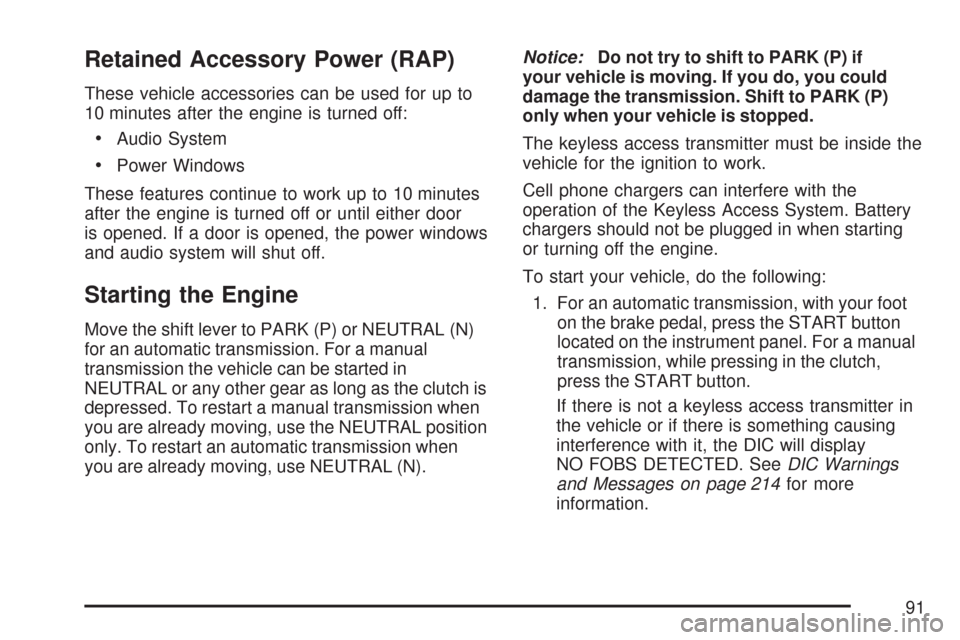
Retained Accessory Power (RAP)
These vehicle accessories can be used for up to
10 minutes after the engine is turned off:
Audio System
Power Windows
These features continue to work up to 10 minutes
after the engine is turned off or until either door
is opened. If a door is opened, the power windows
and audio system will shut off.
Starting the Engine
Move the shift lever to PARK (P) or NEUTRAL (N)
for an automatic transmission. For a manual
transmission the vehicle can be started in
NEUTRAL or any other gear as long as the clutch is
depressed. To restart a manual transmission when
you are already moving, use the NEUTRAL position
only. To restart an automatic transmission when
you are already moving, use NEUTRAL (N).Notice:Do not try to shift to PARK (P) if
your vehicle is moving. If you do, you could
damage the transmission. Shift to PARK (P)
only when your vehicle is stopped.
The keyless access transmitter must be inside the
vehicle for the ignition to work.
Cell phone chargers can interfere with the
operation of the Keyless Access System. Battery
chargers should not be plugged in when starting
or turning off the engine.
To start your vehicle, do the following:
1. For an automatic transmission, with your foot
on the brake pedal, press the START button
located on the instrument panel. For a manual
transmission, while pressing in the clutch,
press the START button.
If there is not a keyless access transmitter in
the vehicle or if there is something causing
interference with it, the DIC will display
NO FOBS DETECTED. SeeDIC Warnings
and Messages on page 214for more
information.
91
Page 93 of 488
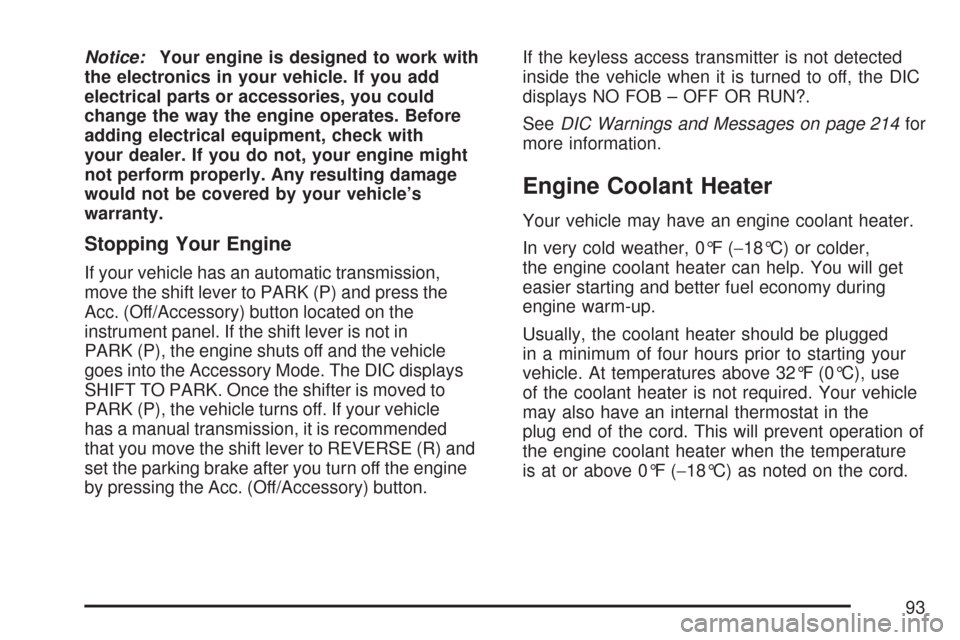
Notice:Your engine is designed to work with
the electronics in your vehicle. If you add
electrical parts or accessories, you could
change the way the engine operates. Before
adding electrical equipment, check with
your dealer. If you do not, your engine might
not perform properly. Any resulting damage
would not be covered by your vehicle’s
warranty.
Stopping Your Engine
If your vehicle has an automatic transmission,
move the shift lever to PARK (P) and press the
Acc. (Off/Accessory) button located on the
instrument panel. If the shift lever is not in
PARK (P), the engine shuts off and the vehicle
goes into the Accessory Mode. The DIC displays
SHIFT TO PARK. Once the shifter is moved to
PARK (P), the vehicle turns off. If your vehicle
has a manual transmission, it is recommended
that you move the shift lever to REVERSE (R) and
set the parking brake after you turn off the engine
by pressing the Acc. (Off/Accessory) button.If the keyless access transmitter is not detected
inside the vehicle when it is turned to off, the DIC
displays NO FOB – OFF OR RUN?.
SeeDIC Warnings and Messages on page 214for
more information.
Engine Coolant Heater
Your vehicle may have an engine coolant heater.
In very cold weather, 0°F (−18°C) or colder,
the engine coolant heater can help. You will get
easier starting and better fuel economy during
engine warm-up.
Usually, the coolant heater should be plugged
in a minimum of four hours prior to starting your
vehicle. At temperatures above 32°F (0°C), use
of the coolant heater is not required. Your vehicle
may also have an internal thermostat in the
plug end of the cord. This will prevent operation of
the engine coolant heater when the temperature
is at or above 0°F (−18°C) as noted on the cord.
93
Page 97 of 488
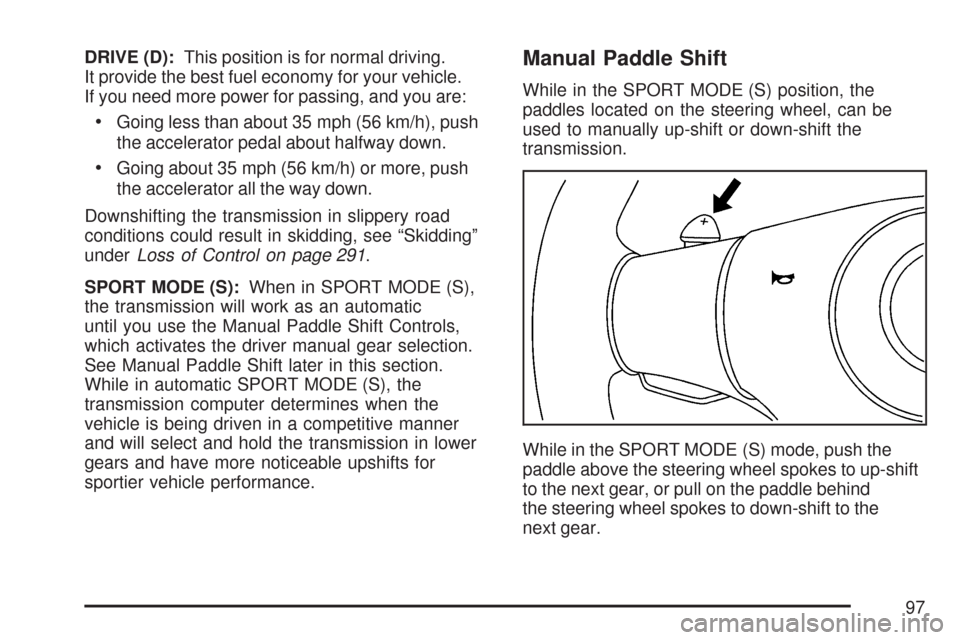
DRIVE (D):This position is for normal driving.
It provide the best fuel economy for your vehicle.
If you need more power for passing, and you are:
Going less than about 35 mph (56 km/h), push
the accelerator pedal about halfway down.
Going about 35 mph (56 km/h) or more, push
the accelerator all the way down.
Downshifting the transmission in slippery road
conditions could result in skidding, see “Skidding”
underLoss of Control on page 291.
SPORT MODE (S):When in SPORT MODE (S),
the transmission will work as an automatic
until you use the Manual Paddle Shift Controls,
which activates the driver manual gear selection.
See Manual Paddle Shift later in this section.
While in automatic SPORT MODE (S), the
transmission computer determines when the
vehicle is being driven in a competitive manner
and will select and hold the transmission in lower
gears and have more noticeable upshifts for
sportier vehicle performance.
Manual Paddle Shift
While in the SPORT MODE (S) position, the
paddles located on the steering wheel, can be
used to manually up-shift or down-shift the
transmission.
While in the SPORT MODE (S) mode, push the
paddle above the steering wheel spokes to up-shift
to the next gear, or pull on the paddle behind
the steering wheel spokes to down-shift to the
next gear.
97
Page 98 of 488
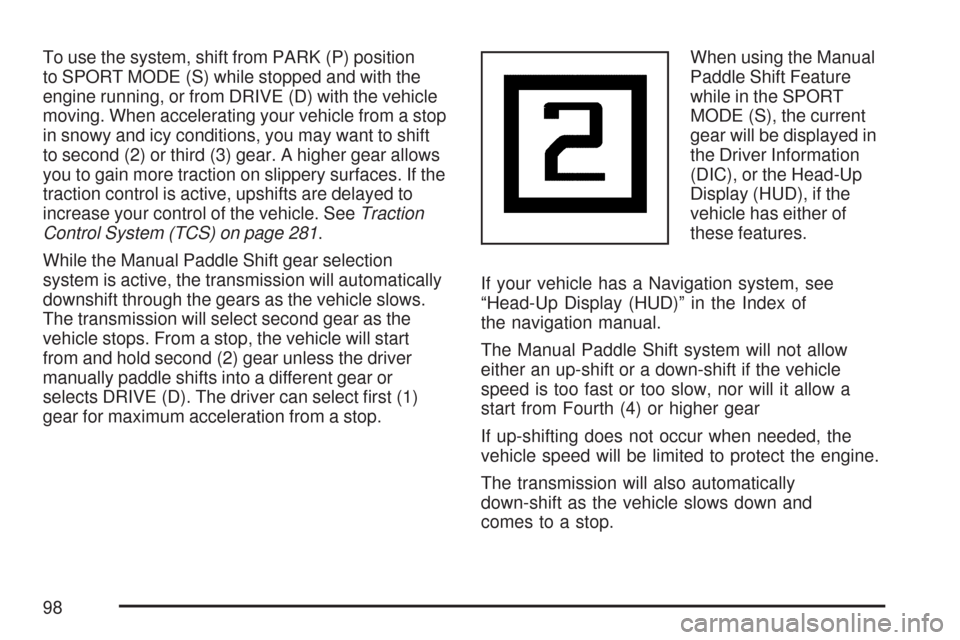
To use the system, shift from PARK (P) position
to SPORT MODE (S) while stopped and with the
engine running, or from DRIVE (D) with the vehicle
moving. When accelerating your vehicle from a stop
in snowy and icy conditions, you may want to shift
to second (2) or third (3) gear. A higher gear allows
you to gain more traction on slippery surfaces. If the
traction control is active, upshifts are delayed to
increase your control of the vehicle. SeeTraction
Control System (TCS) on page 281.
While the Manual Paddle Shift gear selection
system is active, the transmission will automatically
downshift through the gears as the vehicle slows.
The transmission will select second gear as the
vehicle stops. From a stop, the vehicle will start
from and hold second (2) gear unless the driver
manually paddle shifts into a different gear or
selects DRIVE (D). The driver can select �rst (1)
gear for maximum acceleration from a stop.When using the Manual
Paddle Shift Feature
while in the SPORT
MODE (S), the current
gear will be displayed in
the Driver Information
(DIC), or the Head-Up
Display (HUD), if the
vehicle has either of
these features.
If your vehicle has a Navigation system, see
“Head-Up Display (HUD)” in the Index of
the navigation manual.
The Manual Paddle Shift system will not allow
either an up-shift or a down-shift if the vehicle
speed is too fast or too slow, nor will it allow a
start from Fourth (4) or higher gear
If up-shifting does not occur when needed, the
vehicle speed will be limited to protect the engine.
The transmission will also automatically
down-shift as the vehicle slows down and
comes to a stop.
98
Page 99 of 488
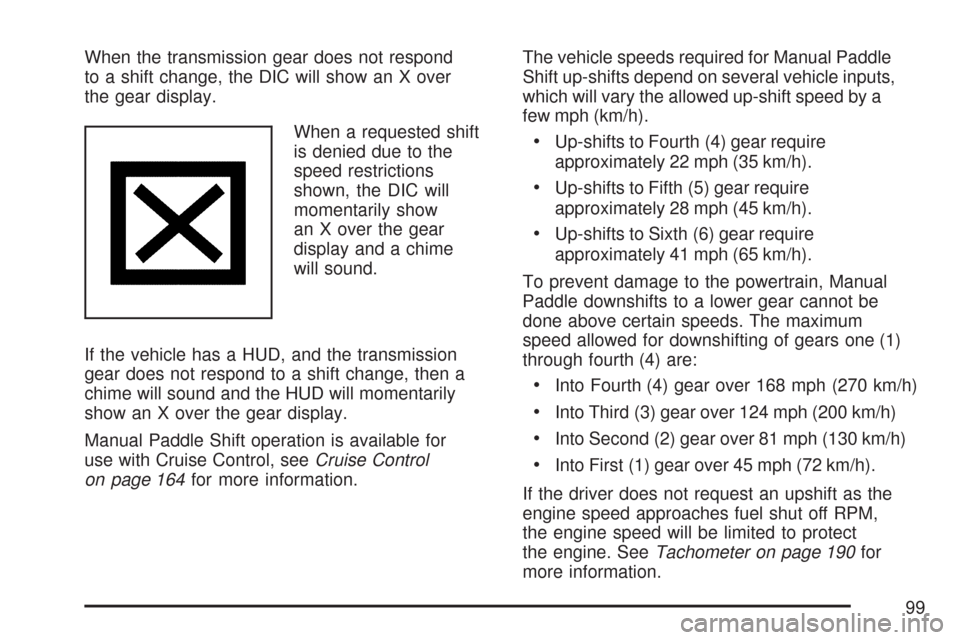
When the transmission gear does not respond
to a shift change, the DIC will show an X over
the gear display.
When a requested shift
is denied due to the
speed restrictions
shown, the DIC will
momentarily show
an X over the gear
display and a chime
will sound.
If the vehicle has a HUD, and the transmission
gear does not respond to a shift change, then a
chime will sound and the HUD will momentarily
show an X over the gear display.
Manual Paddle Shift operation is available for
use with Cruise Control, seeCruise Control
on page 164for more information.The vehicle speeds required for Manual Paddle
Shift up-shifts depend on several vehicle inputs,
which will vary the allowed up-shift speed by a
few mph (km/h).
Up-shifts to Fourth (4) gear require
approximately 22 mph (35 km/h).
Up-shifts to Fifth (5) gear require
approximately 28 mph (45 km/h).
Up-shifts to Sixth (6) gear require
approximately 41 mph (65 km/h).
To prevent damage to the powertrain, Manual
Paddle downshifts to a lower gear cannot be
done above certain speeds. The maximum
speed allowed for downshifting of gears one (1)
through fourth (4) are:
Into Fourth (4) gear over 168 mph (270 km/h)
Into Third (3) gear over 124 mph (200 km/h)
Into Second (2) gear over 81 mph (130 km/h)
Into First (1) gear over 45 mph (72 km/h).
If the driver does not request an upshift as the
engine speed approaches fuel shut off RPM,
the engine speed will be limited to protect
the engine. SeeTachometer on page 190for
more information.
99
Page 100 of 488
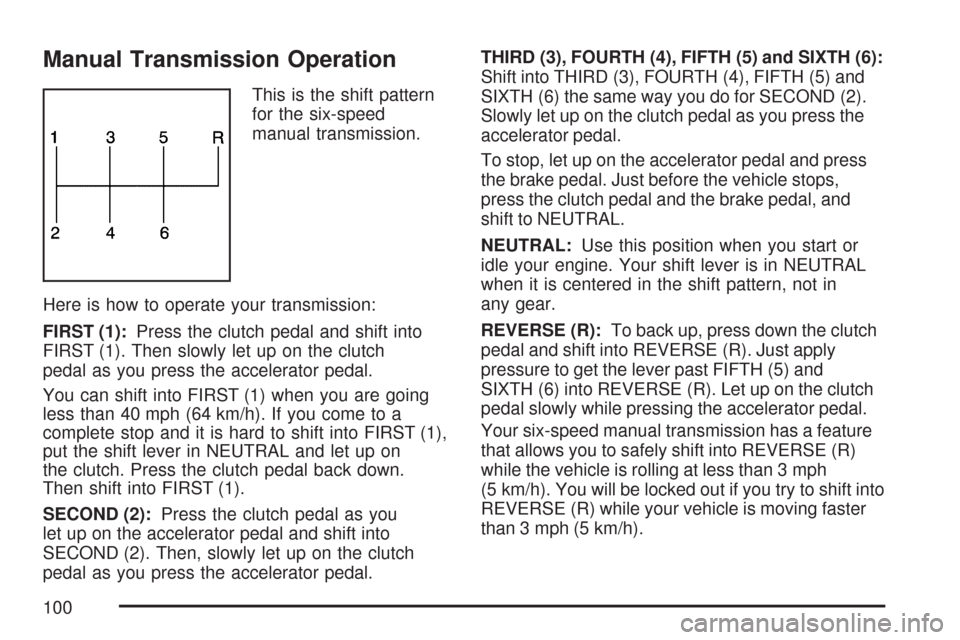
Manual Transmission Operation
This is the shift pattern
for the six-speed
manual transmission.
Here is how to operate your transmission:
FIRST (1):Press the clutch pedal and shift into
FIRST (1). Then slowly let up on the clutch
pedal as you press the accelerator pedal.
You can shift into FIRST (1) when you are going
less than 40 mph (64 km/h). If you come to a
complete stop and it is hard to shift into FIRST (1),
put the shift lever in NEUTRAL and let up on
the clutch. Press the clutch pedal back down.
Then shift into FIRST (1).
SECOND (2):Press the clutch pedal as you
let up on the accelerator pedal and shift into
SECOND (2). Then, slowly let up on the clutch
pedal as you press the accelerator pedal.THIRD (3), FOURTH (4), FIFTH (5) and SIXTH (6):
Shift into THIRD (3), FOURTH (4), FIFTH (5) and
SIXTH (6) the same way you do for SECOND (2).
Slowly let up on the clutch pedal as you press the
accelerator pedal.
To stop, let up on the accelerator pedal and press
the brake pedal. Just before the vehicle stops,
press the clutch pedal and the brake pedal, and
shift to NEUTRAL.
NEUTRAL:Use this position when you start or
idle your engine. Your shift lever is in NEUTRAL
when it is centered in the shift pattern, not in
any gear.
REVERSE (R):To back up, press down the clutch
pedal and shift into REVERSE (R). Just apply
pressure to get the lever past FIFTH (5) and
SIXTH (6) into REVERSE (R). Let up on the clutch
pedal slowly while pressing the accelerator pedal.
Your six-speed manual transmission has a feature
that allows you to safely shift into REVERSE (R)
while the vehicle is rolling at less than 3 mph
(5 km/h). You will be locked out if you try to shift into
REVERSE (R) while your vehicle is moving faster
than 3 mph (5 km/h).
100
Page 101 of 488
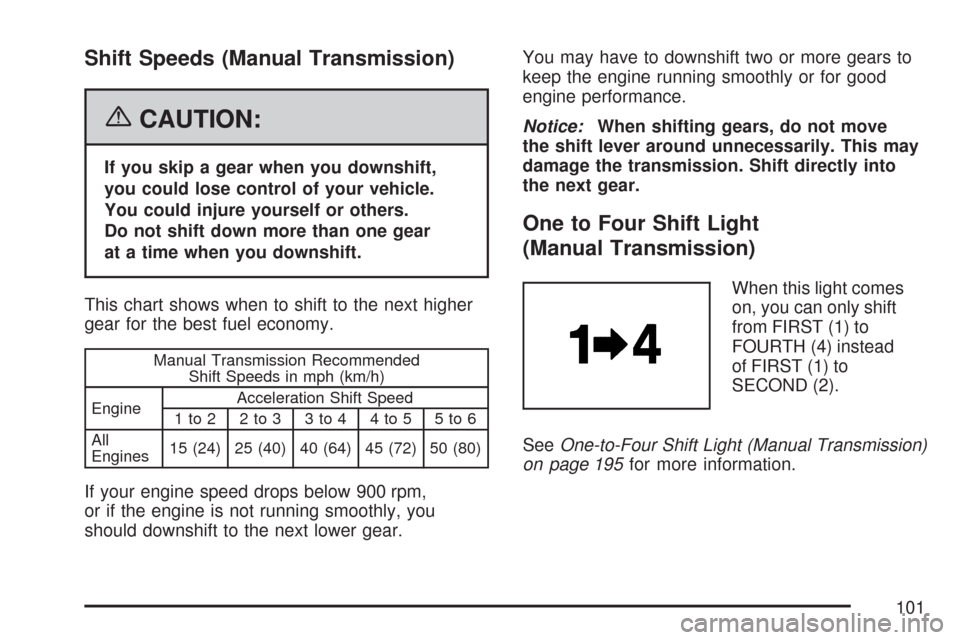
Shift Speeds (Manual Transmission)
{CAUTION:
If you skip a gear when you downshift,
you could lose control of your vehicle.
You could injure yourself or others.
Do not shift down more than one gear
at a time when you downshift.
This chart shows when to shift to the next higher
gear for the best fuel economy.
Manual Transmission Recommended
Shift Speeds in mph (km/h)
EngineAcceleration Shift Speed
1to2 2to3 3to4 4to5 5to6
All
Engines15 (24) 25 (40) 40 (64) 45 (72) 50 (80)
If your engine speed drops below 900 rpm,
or if the engine is not running smoothly, you
should downshift to the next lower gear.You may have to downshift two or more gears to
keep the engine running smoothly or for good
engine performance.
Notice:When shifting gears, do not move
the shift lever around unnecessarily. This may
damage the transmission. Shift directly into
the next gear.
One to Four Shift Light
(Manual Transmission)
When this light comes
on, you can only shift
from FIRST (1) to
FOURTH (4) instead
of FIRST (1) to
SECOND (2).
SeeOne-to-Four Shift Light (Manual Transmission)
on page 195for more information.
101
Page 102 of 488
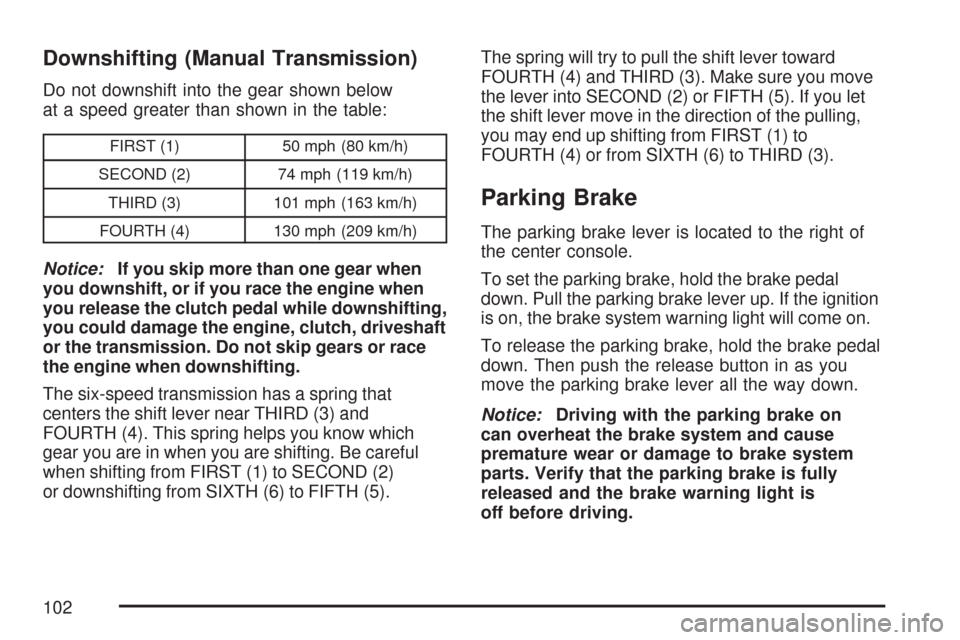
Downshifting (Manual Transmission)
Do not downshift into the gear shown below
at a speed greater than shown in the table:
FIRST (1) 50 mph (80 km/h)
SECOND (2) 74 mph (119 km/h)
THIRD (3) 101 mph (163 km/h)
FOURTH (4) 130 mph (209 km/h)
Notice:If you skip more than one gear when
you downshift, or if you race the engine when
you release the clutch pedal while downshifting,
you could damage the engine, clutch, driveshaft
or the transmission. Do not skip gears or race
the engine when downshifting.
The six-speed transmission has a spring that
centers the shift lever near THIRD (3) and
FOURTH (4). This spring helps you know which
gear you are in when you are shifting. Be careful
when shifting from FIRST (1) to SECOND (2)
or downshifting from SIXTH (6) to FIFTH (5).The spring will try to pull the shift lever toward
FOURTH (4) and THIRD (3). Make sure you move
the lever into SECOND (2) or FIFTH (5). If you let
the shift lever move in the direction of the pulling,
you may end up shifting from FIRST (1) to
FOURTH (4) or from SIXTH (6) to THIRD (3).
Parking Brake
The parking brake lever is located to the right of
the center console.
To set the parking brake, hold the brake pedal
down. Pull the parking brake lever up. If the ignition
is on, the brake system warning light will come on.
To release the parking brake, hold the brake pedal
down. Then push the release button in as you
move the parking brake lever all the way down.
Notice:Driving with the parking brake on
can overheat the brake system and cause
premature wear or damage to brake system
parts. Verify that the parking brake is fully
released and the brake warning light is
off before driving.
102